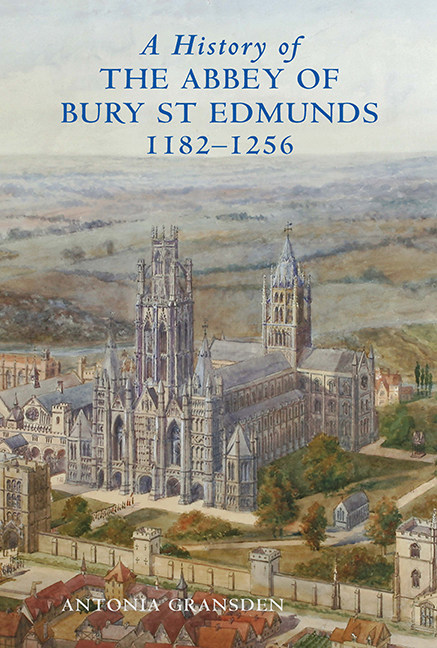Book contents
- Frontmatter
- Dedication
- Contents
- List of plates
- List of figures
- Preface
- Editorial Note
- Epigraph
- Acknowledgements
- Maps and plans (figures 1–9)
- Part I Samson of Tottington, Abbot 1182–1211
- 1 Samson's biographer, Jocelin of Brackland (de Brakelond), and his work
- 2 Samson's early life and career
- 3 Samson's election to the abbacy
- 4 The early years of Samson's abbacy and reform of estate management
- 5 Conflict with the convent
- 6 Relations with the town of Bury St Edmunds
- 7 Samson and secular law
- 8 Samson and the knights of St Edmund
- 9 Relations with the Angevin kings
- 10 Samson and the papacy
- 11 Samson as a builder
- 12 Religious and intellectual life under Samson
- 13 Samson's death and burial
- PART II The Abbey 1212–1256
- APPENDICES
5 - Conflict with the convent
from Part I - Samson of Tottington, Abbot 1182–1211
Published online by Cambridge University Press: 29 April 2017
- Frontmatter
- Dedication
- Contents
- List of plates
- List of figures
- Preface
- Editorial Note
- Epigraph
- Acknowledgements
- Maps and plans (figures 1–9)
- Part I Samson of Tottington, Abbot 1182–1211
- 1 Samson's biographer, Jocelin of Brackland (de Brakelond), and his work
- 2 Samson's early life and career
- 3 Samson's election to the abbacy
- 4 The early years of Samson's abbacy and reform of estate management
- 5 Conflict with the convent
- 6 Relations with the town of Bury St Edmunds
- 7 Samson and secular law
- 8 Samson and the knights of St Edmund
- 9 Relations with the Angevin kings
- 10 Samson and the papacy
- 11 Samson as a builder
- 12 Religious and intellectual life under Samson
- 13 Samson's death and burial
- PART II The Abbey 1212–1256
- APPENDICES
Summary
Under the Rule of St Benedict an abbot's power is absolute. Decision-making lies with him and the monks must obey his commands, however unreasonable, without question and with humility. Nevertheless, the Rule has general injunctions for the abbot's good behaviour: he must always be mindful of the words of St Paul: ‘you have received the spirit of the adoption of sons by which we cry Abba, father’. And the abbot should not harass the flock committed to him, nor exercise his power in an arbitrary, unjust way; he should always remember that he must render account to God for all his decisions and acts. Moreover, the Rule states that when an important decision has to be taken, the abbot should call all the monks together, explain the situation and listen to their advice, even to the views of young monks, before deciding what to do. He was also to consult ‘God fearing monks’ when appointing a prior, and senior monks should be consulted over small matters: the Rule cites the Book of Sirach (Ecclesiasticus): ‘Do all things with counsel and you will not afterwards repent.’ These stipulations in the Rule were advices to the abbot and did not imply rights enjoyed by the monks.
However, in the course of time monks came to claim certain rights which had evolved as customs and received tacit or formal recognition by their abbots. The proliferation of such rights was greatly accelerated by the division of property between abbot and convent in the eleventh and twelfth centuries. As a result, disputes between an abbot and his monks over their respective rights were a constant threat. If an abbot grossly abused his power and violated rights claimed by his monks, the latter could appeal to the local bishop, provided that the monastery in question was not exempt from diocesan authority. St Edmunds, having the privilege of full exemption, could only be visited by the pope himself by a legate a latere, that is, one with plenary powers. Jocelin, a novice at the time, realized the danger to the monks of full exemption:
- Type
- Chapter
- Information
- A History of the Abbey of Bury St Edmunds, 1182–1256Samson of Tottington to Edmund of Walpole, pp. 32 - 43Publisher: Boydell & BrewerPrint publication year: 2007



